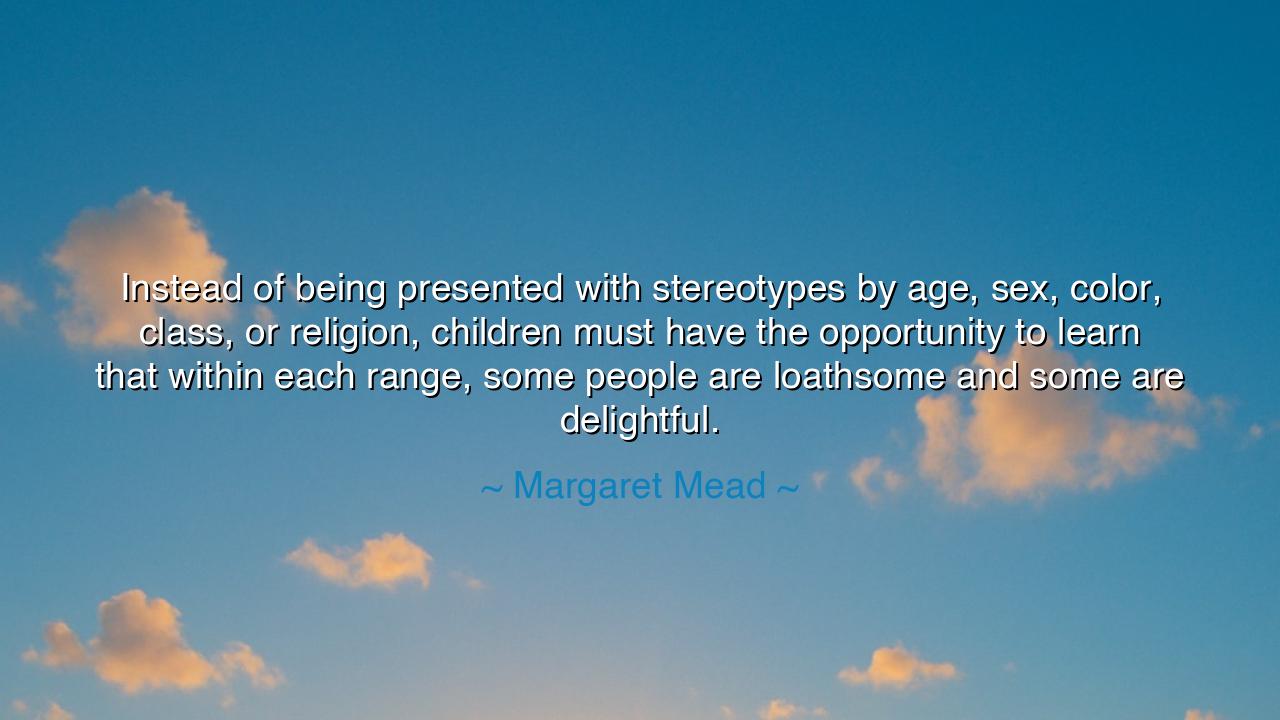
Instead of being presented with stereotypes by age, sex, color
Instead of being presented with stereotypes by age, sex, color, class, or religion, children must have the opportunity to learn that within each range, some people are loathsome and some are delightful.






"Instead of being presented with stereotypes by age, sex, color, class, or religion, children must have the opportunity to learn that within each range, some people are loathsome and some are delightful." — so declared Margaret Mead, the great anthropologist of the twentieth century, whose gaze crossed oceans and cultures to uncover the shared heart of humanity. In these words lies a timeless call — a plea for clarity, for compassion, and for the education of the soul. She reminds us that the true study of humankind begins not in division, but in discernment: that no category defines the worth of a person, and that virtue and vice flow not from group or label, but from the choices of the individual spirit.
In the style of the ancients, one might say: to judge by tribe is easy, to see the person within is divine. Mead’s wisdom was born of long travels among distant peoples, where she saw that humanity wears many garments, but the heart beneath beats the same. In Samoa, in New Guinea, and across the Pacific, she studied the customs of men and women, of the young and the old, not to divide, but to understand. From those journeys arose her conviction — that prejudice blinds the mind, while understanding opens it. She knew that when we teach children to see the world through the fog of stereotype, we cripple their vision before it ever learns to see.
Her words strike at the root of all narrowness. The world, she teaches, is not divided between the good and the wicked by race, or class, or creed — but by the secret inclinations of the heart. To say that all of one kind are virtuous or vile is to deny the complexity of existence. The human soul cannot be measured by skin, or wealth, or belief; it can only be known through encounter. Children, therefore, must be taught to look beyond appearances — to meet each person as a mystery, capable of both cruelty and kindness. This, Mead says, is the beginning of wisdom: to see humanity not as a map of divisions, but as a living field of possibility.
Consider the story of Abraham Lincoln, who in his youth grew up amid a world divided by color and class. He was taught, as many were, to see the enslaved as lesser beings. But through the cultivation of conscience and the courage to look deeper, he learned a different truth — that dignity dwells in every human soul, regardless of the chains that bind it. It was this awakening, this rejection of stereotype, that allowed him to act not as a man of his time, but as a man beyond it. He saw not the slave, but the human. Not the category, but the person. And in that sight, the course of a nation changed.
So too, Margaret Mead’s vision challenges us to rise above the lazy ease of prejudice. It is tempting to sort the world into simple boxes — to say “these are good” and “those are evil,” “these belong to us” and “those are other.” But wisdom is born of complexity. To recognize that “some are loathsome and some are delightful” in every group is to restore balance to judgment and humility to the heart. It is to admit that goodness is not the inheritance of birth, but the work of character.
The lesson of Mead’s words, then, is both moral and practical: teach children to think, not to hate; to observe, not to assume; to seek the content of a person’s heart before accepting the stories told about them. Prejudice is not unlearned through silence — it is unlearned through encounter. Let children read stories of many peoples, walk in many neighborhoods, speak with those unlike themselves. Let them learn that humanity, like a field of wildflowers, gains its beauty through variety. Only then can they grow into adults who build bridges rather than walls.
And so, my child, remember the wisdom of Margaret Mead — that every soul must be met anew. Do not let the world hand you its ready-made judgments; make your own through the eyes of compassion. When you meet a stranger, look not for category, but for character. When you see difference, do not fear it — explore it. For in every age, in every nation, and in every heart, there are those who harm and those who heal. The task of the wise is to tell them apart — not by the color of their skin, nor the symbols they wear, but by the light or darkness that lives within.






AAdministratorAdministrator
Welcome, honored guests. Please leave a comment, we will respond soon